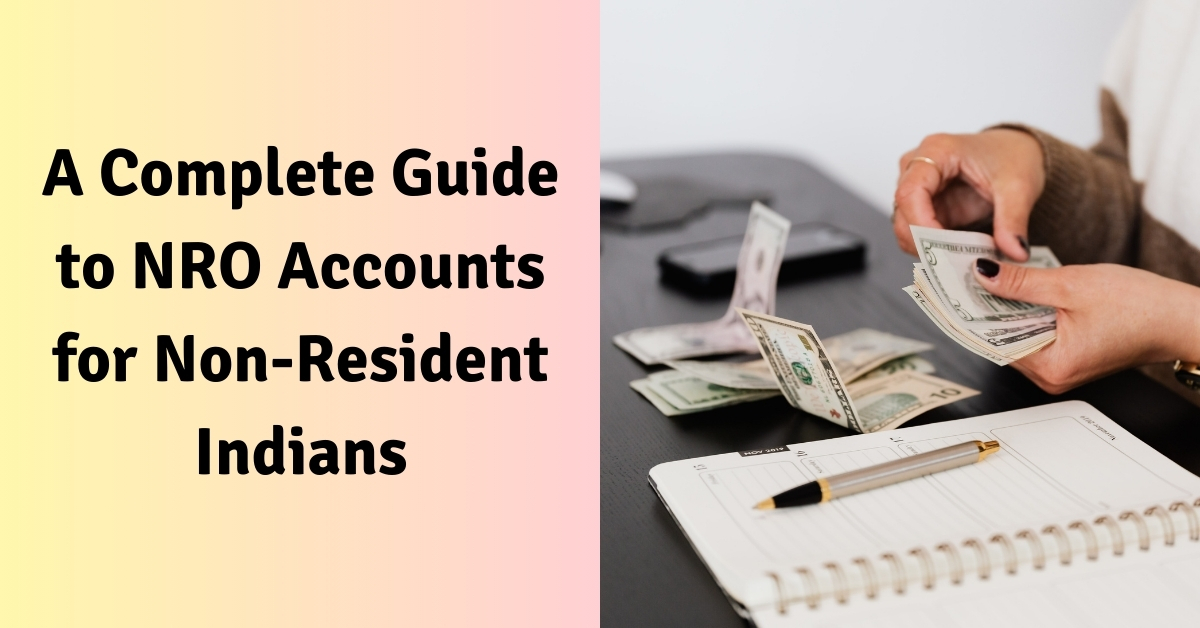A Complete Guide to NRO Accounts for Non-Resident Indians

Establishing a Non-Resident Ordinary (NRO) account is a crucial step for Non-Resident Indians (NRIs) aiming to manage their India-sourced income, such as rental proceeds, dividends, or pension payments.
Whether you’re residing overseas with financial ties to India or planning an international relocation, understanding the NRO account opening process is essential.
This detailed guide will walk you through the procedure, ensuring you’re well-equipped to efficiently handle your Indian earnings.
Demystifying NRO Accounts Before delving into the account opening process, let’s clarify what an NRO account entails. It’s a rupee-denominated bank account in India that allows NRIs to manage income generated within the country.
While the interest earned is subject to Indian taxation, it provides a straightforward method for collecting and distributing your Indian earnings.
Advantages of an NRO Account Tax Compliance: Streamlines taxation on your Indian income. Financial Control: Simplifies management of your Indian expenses.
Savings Potential: Enables saving in INR and earning interest.
NRO Account Opening Procedure
Step 1: Choose Your Financial Institution Research banks offering NRO account services. Compare features like interest rates, service charges, and digital banking options.
Step 2: Gather Required Documentation Passport and visa photocopies. Proof of Overseas Residence (utility bill or tenancy agreement). Proof of Indian Address (if available). Current Photographs. PAN Card or Form 60.
Step 3: Initiate Application NRO Account Online Setup
Many banks now provide the convenience of opening NRO accounts digitally. Visit the bank’s official website and navigate to the NRI banking section. Complete the online application form with your personal and financial details.
Step 4: Verification and Activation Process Upon submission, the bank will scrutinize your documents. This may include a video KYC in some instances. Once verified, your account will be activated, and you’ll receive notification via email or SMS.
Step 5: Initial Account Funding An initial deposit may be necessary to activate your account. This can typically be transferred from your existing bank account.
Key Factors to Consider Interest Rates:
Verify current rates and compounding frequency.
Service Fees: Be aware of any maintenance charges or fees for not maintaining a minimum balance.
Digital Banking: Ensure the bank offers comprehensive online banking services for easy account management.
NRO Account Management Digital Banking:
Utilize online services for convenient fund management, bill payments, and money transfers.
Tax Implications: Interest income from NRO accounts is subject to TDS (Tax Deducted at Source) in India. Seek advice from a tax professional for detailed guidance.
Navigating the Process: In-depth Insights Establishing an NRO account is more than just a procedural necessity for NRIs; it’s a strategic financial decision that requires careful consideration and planning.
Beyond the basic steps, several nuances and best practices can help streamline the process and ensure you’re maximizing the benefits of your account.
Selecting the Ideal Bank Reputation and Reliability: Opt for a bank with a strong reputation and robust presence both in India and your country of residence. This ensures dependability and ease of access to international banking services. Comprehensive Banking Solutions: Consider banks that offer a suite of NRI services beyond just an NRO account, including investment options, loans, and insurance, to address all your financial needs in India.
Digital Banking Capabilities In today’s digital age, the ability to manage your account remotely is crucial:
User-Friendly Online Platform: Ensure the bank’s digital platform is secure, intuitive, and offers comprehensive features such as bill payments, fund transfers, and statement downloads. Mobile Banking
Application: A smartphone app that allows you to access your account on the go can significantly enhance your banking experience, offering convenience and real-time management of your finances.
Post NRO Account Activation Once your NRO account is operational, there are several considerations to keep in mind for its management:
Regular Monitoring: Frequently review your account statements to track transactions and check for any discrepancies.
Tax Planning: Consult with a tax advisor specialized in NRI taxation to understand your tax obligations in India and explore avenues for tax-efficient investments.
Estate Planning: Consider nominating a family member for your NRO account to ensure smooth succession and access to funds in your absence.
Engaging with Customer Support Responsive Customer Service: Select a bank that offers prompt and knowledgeable customer support, preferably with a dedicated NRI helpline, to address any queries or concerns you might have.
The Future of NRO Banking Innovations in Banking: Stay informed about the latest banking innovations and services offered to NRIs, as banks continually enhance their NRO account offerings to include more digital services, investment platforms, and tailored financial products.
Conclusion
Establishing an NRO account is a significant step for NRIs to manage their finances in India. With the advent of digital banking, the process of opening an NRO account has become more straightforward and accessible.
By following the steps outlined in this guide and choosing the right banking partner, you can ensure that your earnings in India are managed efficiently and effectively.
Remember, staying informed and selecting the right account features that align with your financial needs are key to maximizing the benefits of your NRO account.
FAQs’
- Is it possible to open an NRO account online from any country?
Ans- Yes, most banks allow you to initiate the process online from anywhere. However, verify with your chosen bank for any country-specific restrictions.
- What is the typical timeframe for opening an NRO account?
Ans- The duration can vary based on the bank and documentation. Generally, the account can be activated within a few days to a few weeks after all documents are verified.
- Can I convert my existing savings account to an NRO account?
Ans- Yes, if you become an NRI, you are required to inform your bank to convert your existing savings account into an NRO account.
- Am I allowed to hold multiple NRO accounts?
Ans- Yes, NRIs can maintain multiple NRO accounts with different banks.
- What income can I put into an NRO account?
Ans- You can deposit various types of income into an NRO account, like rent, dividends, pension payments, and interest from Indian investments, as well as other Indian income.
- Are there limits on how I can withdraw money from an NRO account?
Ans- You can withdraw money from an NRO account, but there are limits on how much you can send abroad. Repatriating funds usually involves limits and requires certain paperwork and tax compliance.
- How do I handle currency conversion with an NRO account?
Ans- An NRO account holds money in Indian Rupees (INR). To convert this to your home currency or transfer it abroad, you’ll need to use your bank or a currency exchange service.
- What happens to my NRO account if I move back to India?
Ans- If you move back to India, you’ll need to change your NRO account to a regular savings account or a Resident Foreign Currency (RFC) account. Let your bank know about your change in residency so they can update your account.
- Are there any tax benefits for having an NRO account?
Ans- There aren’t specific tax benefits for having an NRO account. However, it helps you manage and report Indian income. Interest earned is taxed at source, but you might get tax credits or deductions depending on your overall tax situation.
- Can I use an international ATM card with my NRO account?
Ans- Yes, many banks provide international ATM cards for NRO accounts, letting you access your money while abroad. Check with your bank about how to get the card, any fees, and limits on international use.



